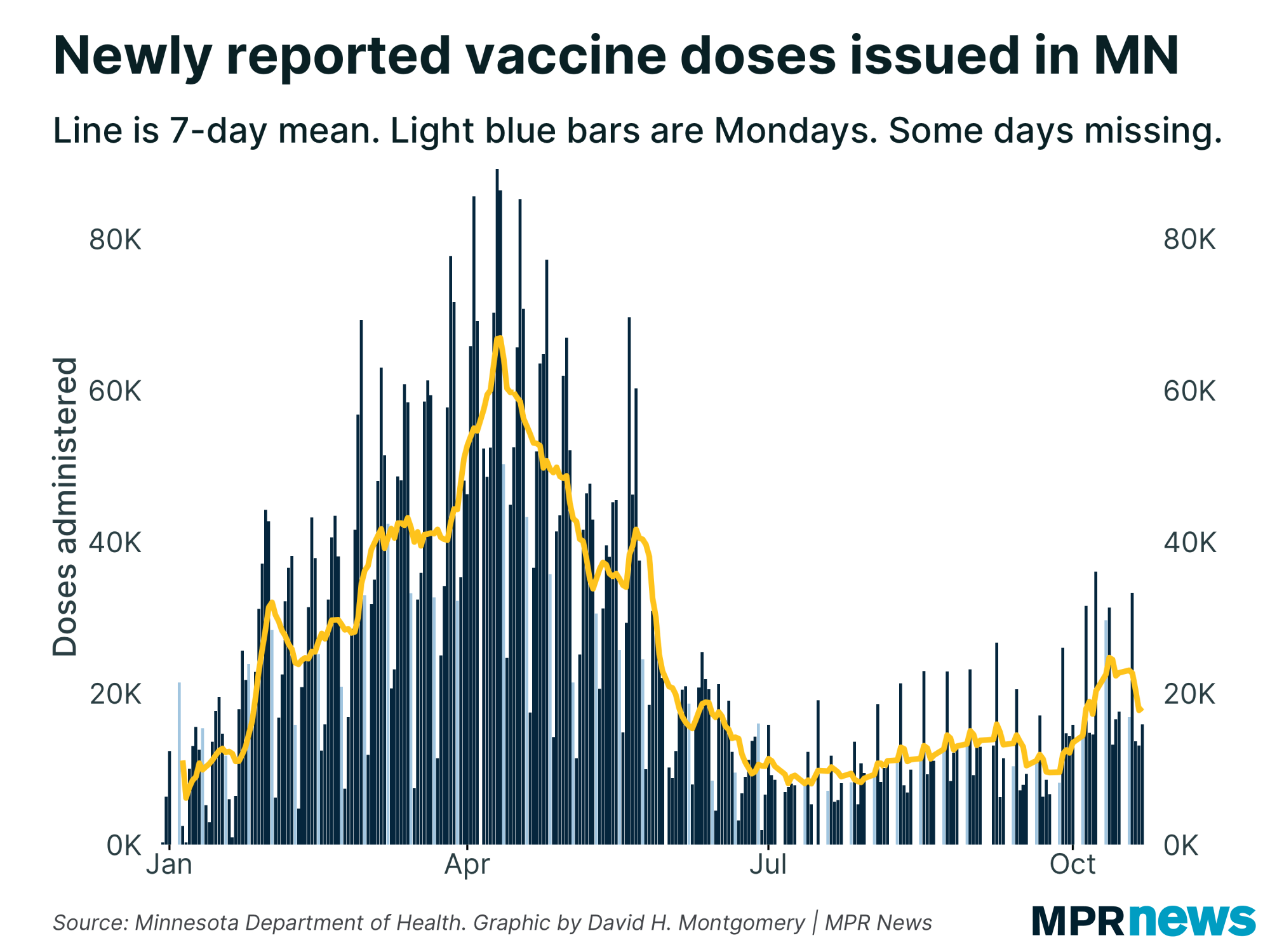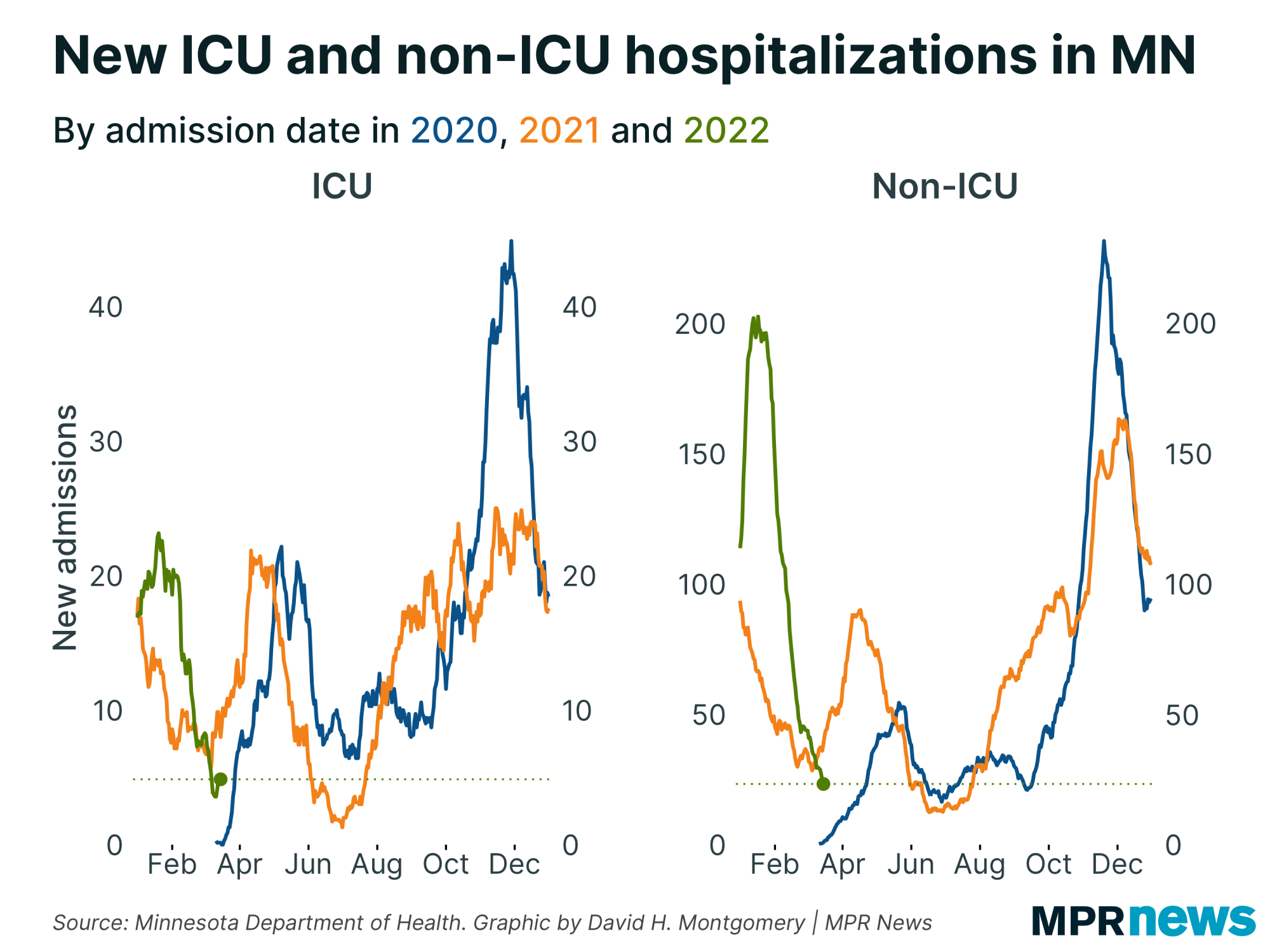Feb. 21 update on COVID-19 in MN: Vaccination pace stays relatively flat

Go Deeper.
Create an account or log in to save stories.
Like this?
Thanks for liking this story! We have added it to a list of your favorite stories.
3 things to know:
Vaccination pace holds steady; no sign of weather delays
More than half of new vaccinations are second doses
Overall pandemic metrics look encouraging
The pace of COVID-19 vaccinations in Minnesota stayed relatively flat in Sunday’s update from state health officials, with no sign yet of a decline due to weather-delayed vaccine shipments.
Averaged over the past week, the number of vaccine doses administered each day ticked upward slightly, to just under 30,000.
But more than half of the new vaccinations reported Sunday were second doses, allowing people to complete their vaccinations. The number of people getting their first vaccine dose has been falling in recent days.
There’s a lag time in reporting vaccination info — Sunday’s update from state health officials reflects data as of Friday — so it’s possible that the effects of the past week’s severe winter weather on vaccine shipments may show up in the coming days. Some vaccination appointments in Minnesota over the weekend were postponed due to those delays.
Turn Up Your Support
MPR News helps you turn down the noise and build shared understanding. Turn up your support for this public resource and keep trusted journalism accessible to all.

About 13.6 percent of Minnesotans had received at least one dose as of the latest update, with about 6.1 percent completely vaccinated. More than 41 percent of Minnesotans 65 and older have received at least one shot.
The total number of vaccine doses administered now stands at 1,097,679.
Here are Minnesota’s current COVID-19 statistics:
6,432 deaths (9 new)
479,036 positive cases (891 new), 465,382 off isolation (97 percent)
7.2 million tests, 3.4 million Minnesotans tested (about 59 percent of the population)
13.6 percent of Minnesotans vaccinated with at least one dose
State public health leaders have emphasized over the past weeks that the relatively low flow of vaccine supplies from the federal government is the main problem holding back the pace of vaccinations.
While recent vaccination numbers are trending upward, Minnesota at the current pace would only be able to vaccinate about 80 percent of adults by sometime in September. Getting it done by summer would require the state to administer 40,000 to 50,000 shots per day, or more.
Minnesota is currently ranked 20th among states in doses administered per 100,000 people, according to data collected by the federal Centers for Disease Control and Prevention.
Vaccination questions aside, Minnesota’s COVID-19 numbers show the state on a steady, positive path, with key pandemic metrics continuing to improve. Known, active cases held steady at just over 7,200, but the overall trend is solid, hovering around late September levels.

The seven-day hospital admissions trend for people with COVID-19 has also receded to September levels.

Nine reported deaths on Sunday raised Minnesota’s toll to 6,432. Among those who’ve died, about 63 percent had been living in long-term care or assisted living facilities; most had underlying health problems.

The seven-day rolling average for deaths is at eight deaths per day, near the lowest since September.
The state has recorded 479,036 total confirmed or probable cases so far in the pandemic, including 891 reported Sunday. About 97 percent of Minnesotans known to be infected with COVID-19 in the pandemic have recovered to the point they no longer need to be isolated.

State health officials continue to monitor new virus strains circulating in the United States, which may be more contagious.
Cases spread across age groups, regions
People in their 20s still make up the age bracket with the state’s largest number of confirmed cases — more than 90,000 since the pandemic began, including more than 47,000 among people ages 20 to 24.

The number of high school-age youth confirmed with the disease has also grown, with more than 37,000 total cases among those ages 15 to 19 since the pandemic began.
Although less likely to feel the worst effects of the disease and end up hospitalized, experts worry youth and young adults will spread it unknowingly to older relatives and members of other vulnerable populations.
People can have the coronavirus and spread COVID-19 when they don’t have symptoms.
Regionally, most parts of Minnesota are down significantly from the late November, early December spike as well as a January blip.
There has been an uptick in cases in northwestern Minnesota recently, though it’s unclear why just yet.

Caseloads still heaviest among people of color
In Minnesota and across the country, COVID-19 has hit communities of color disproportionately hard in both cases and deaths. That’s been especially true for Minnesotans of Hispanic descent for much of the pandemic.

Even as new case counts continue to fall from their late November, early December peaks, the data shows Latino people continue to be hit hard.
Distrust of the government, together with deeply rooted health and economic disparities, have hampered efforts to boost testing among communities of color, officials say, especially among unauthorized immigrants who fear their personal information may be used to deport them.
Last week, Minnesota Health Commissioner Jan Malcolm acknowledged the need to ensure that vaccination opportunities be spread equitably.
Malcolm said the state will release data soon regarding vaccinations, race and ethnicity. Officials say they’re trying to improve the quality of data. Per state law, it's been shared voluntarily, and so may be inconsistent.
COVID-19 in Minnesota
Data in these graphs are based on the Minnesota Department of Health's cumulative totals released at 11 a.m. daily. You can find more detailed statistics on COVID-19 at the Health Department website.
Developments from around the state
Minneapolis lifts bar counter restrictions
The city of Minneapolis has lifted its ban on bar counter seating just in time for the weekend.
Minneapolis Mayor Jacob Frey said the decision was based on public health data, showing a decrease in COVID-19 cases in the city.
Bars in the city must still require reservations, social distancing and no more than two customers can be seated together at a bar counter.
Establishments also have to lower music volume to keep patrons from talking loudly and sitting too close together.
Last week, citing vaccine progress in the state, Gov. Tim Walz loosened some pandemic-related regulations that allow bars to be open one hour longer, until 11 p.m.
— Nina Moini | MPR News
Top headlines
COVID drives home schooling surge as public school enrollment drops: The COVID-19 crisis is driving dramatic changes in Minnesota public school enrollments, including a drop of some 17,000 students in the past year, with families delaying kindergarten and choosing options outside the public system, the state Education Department says.
Collaboration between White Earth Nation, Mahnomen Co. leads to one of highest vaccination rates in MN: Since Minnesota began distributing coronavirus vaccines late last year, Mahnomen County in northwestern Minnesota has consistently led the pack.
Michael Osterholm on how new COVID variants could change the pandemic's trajectory: As vaccinations continue, new variants of the virus are spreading. Scientists worry that the vaccine could be less effective against these mutations and that infection rates might rise again if one of these variants becomes the dominant strain.
New vaccine tool will tell Minnesotans when they can get COVID-19 shots: The tool will alert Minnesotans of their eligibility, connect them to resources to schedule an appointment and provide information on nearby vaccination opportunities. Minnesotans will still have to make their own appointment to get a shot through a vaccine provider.



